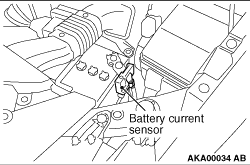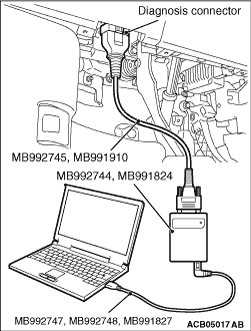|
|
The engine-ECU carries out the electrical generation control according to the charge level
of the battery, based on the battery current sensor signal. To improve the effect of reducing the
fuel consumption by the electrical generation control, it is necessary to accurately detect
the charge level of the battery. For this, if the following services are performed, carry out
the battery current sensor calibration.
|
|
|
- Replacing the battery current sensor
- Replacing the engine-ECU
|
|
|
1.After the ignition switch is in "LOCK" (OFF) position, disconnect the battery cable
from the negative battery terminal.
|

|
2.Remove the battery current sensor from the battery cable (do not disconnect the battery
current sensor connector).
3.Connect the battery cable without the battery current sensor to the negative battery
terminal.
|

|
4.Connect the M.U.T.-III to the diagnosis connector (but do not start the engine).
5.Turn the ignition switch to the ON position.
6.Select "MPI/GDI/DIESEL" from System select Screen of the M.U.T.-III.
7.Select "Special Function" from MPI/GDI/DIESEL Screen.
8.Select "Learning" from Special Function Screen.
9.Select "Battery current SNSR.calibration" from Learning Screen.
10.Start the calibration by pressing the "OK" button.
11.Confirm that the M.U.T.-III data list item No. 452 Battery current sensor calibration
is "Completed".
12.After the ignition switch is in "LOCK" (OFF) position, disconnect the M.U.T.-III.
13.Install the battery current sensor.
|
